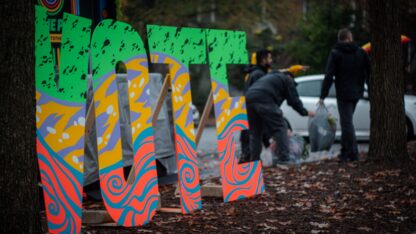City Panel To Mull Confederate Symbols But How Many Are There?

A statue depicting a Confederate soldier in Piedmont Park in Atlanta is vandalized with spray paint Monday, Aug. 14, 2017, from protesters who marched through the city last night to protest the weekend violence in Charlottesville, Virginia. (AP Photo/David Goldman)
Atlanta Mayor Kasim Reed has announced plans to put together a panel of leaders to consider the future of the city’s Confederate symbols and street names. They’ll have two months, but they may not have all that many items to discuss.
There just aren’t that many Confederate-related memorials in this particular southern city.
“Atlanta was more of a forward looking city, and that doesn’t mean we were necessarily better or less racist,” said Sheffield Hale, president of the Atlanta History Center.
He said after the Civil War, city leaders were far more interested in bringing in Northern money than memorializing the lost cause.
Atlanta’s Confederate-related monuments are much more likely than other southern capitals to have been installed immediately after the war, specifically to mourn the dead, according to Hale. The obelisk in Oakland Cemetery is a pronounced example.
“Those monuments are a different character than most of the monuments we’re talking about today, which were put up between 1890 and 1920 which deal more with the lost cause and the promotion of white racial supremacy,” Hale said.
An online petition to rename Grant Park’s Confederate Avenue has more than eight thousand signatures.
But again, Hale said, citywide, the list of streets to call attention to is as short as it’s ever been.
“We’ve gone through a couple of street renaming over the years so a lot of the ones that people consider the most problematic have already been changed — like Forrest Avenue is gone,” he said.
It had been named after Confederate general and Ku Klux Klan leader Nathan Bedford Forrest. It’s now Ralph McGill Boulevard.
That said, Hale added, beyond the Confederacy, there’s no shortage of prominent white supremacists on display.
The likenesses of Georgia’s former governors there consist of a plurality of men whose legacies include having fought to protect the segregated south.
As with our granite, monolithic neighbor to the east, Stone Mountain, changing those statutes would involve tangling with state law, something over which city officials have far less control.







